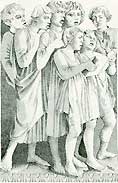Aesthetics and Education
What
is the purpose of education? Is it not to promote an understanding and development of all the qualities of
humanity, not only of intellect and knowledge, but also of aesthetics, of enquiry, of openness, of research, of
social cohesion, even of physical training. How can one test a pupil's reaction to and influence by such important
questions as aesthetic appreciation of music, art and literature, morality, the demands of citizenship, and the need
to be open and enquiring to the responsibilities of being adult? These questions lift humanity from being a product
of politics and business to being an ever evolving species capable of coping with the demands of what it is to be
human in not so much an earth but universe situation with its whole spectrum of challenges, questions and
puzzles.
How important are Aesthetics in Education, especially to the
Government? In the UK the outlook is bleak. Religious Education, which encompasses not only an
appreciation of the world's religions but also ethics and social cohesion, may be a core subject but this is ignored
by a third of all secondary schools. In terms of examinations Religious Education has lost one third of candidates
in the last year. In the White Paper the Government produced in 2010 (revised 2011) we read the reasons for an
intended reform: "In the most recent OECD PISA survey in 2006 we fell from 4th in the world in the 2000
survey to 14th in science, 7th to 17th in literacy, and 8th to 24th in mathematics .... more young people are
achieving qualifications, but it is no coincidence that many of the qualifications which have grown in
popularity recently are not those best recognised by employers and universities, but those which carry the
highest value in school performance tables .... schools have become skilled at meeting government targets but
too often have had their ability to do what they think is right for their pupils constrained by government
directives or improvement initiatives." Notice the driving force of reform is science, literacy and
maths. Consequently the Government have produced "a vision for a transformed school curriculum supported by
rigorous assessment and qualifications." This includes targets which are to be introduced in primary
schools for the first time.
The white paper indicates that a school's performance will now be based on
the English Baccalaureate as the new standard in secondary education. This identifies 5 core subjects, English,
Maths, Science (Physics, Chemistry, Biology), languages, humanities (History or Geography). The measure is intended
to make it easier to identify “those schools which succeed in giving their pupils a properly rounded academic
education”. How depressing!
Political interference with education. Any
government is under enormous pressure from industry to produce a skilled workforce, which inevitably means accenting
education on such left hemispherical subjects as mathematics, science and computer literacy. This may succeed to a
limited extent when students with such training gain meaningful employment. What happens then when up to half such
students fail to obtain work of any degree? For them their education has been a waste of time if they are not taught
the core values of aesthetics - how to understand their humanity by being creative, and developing a sense of self
worth and social integration. The government has failed them. The consequences of such policies are all too clear to
see in our present society.
Governments want tangible results, not enlightened
citizens. The cause is the two major problems with such government led and funded education face. The
first is the need to show demonstrable results for money spent, i.e. by left hemisphere orientated results and
league tables. The second is the need for employment orientated education, the result of a perceived need to sustain
a positive balance of payments through industrial development and innovation. The sustained lobbying of business
interests and technology as to the type of education they require for their employees holds far more sway with
modern focus-driven politicians than does any philosophical educational theory. Consequently, to the left of centre
we see an overburdening of politically correct initiatives and targets, which seems to destroy any forward, stable
and coherent momentum, while to the right we see a hidden agenda of movement to privatisation and the demands of
industry. Neither produces a rounded education simply because true education, that of aesthetics, or of what it is
to be human cannot be tested and quantified, i.e. the present league tables and examination systems are too
simplistic to gauge how rounded an education any pupil has received and how good a citizen he or she may become.
Thus we see the inevitable problems of the young who, having completed their university courses, find no employment.
On the one hand they feel let down, that the government owes them a living because they have passed a set of narrow
left hemisphere qualifications none of which have included any development of right hemisphere self worth.
Everything depends on material development and its continuation. Life has been reduced to one of physical
dimensions. Humanity is greater than that but, to any government, this is the realms of philosophy and so means
nothing.
In 2006 Unesco produced a report on aesthetics in education.
Historically in the 19th and 20th centuries (Ruskin and Morris through the Arts and Crafts Movement) aesthetic
education was seen as a counterbalance to rationalisation and intellectualism. 20th century philosophy (notably
Maxine Greene and Burton in 1994) now understood aesthetics as a means of teaching students how to develop and
understand a sense of creativity and imagination (theirs and others), and so develop a sense of self management,
discipline and worth, and through this, how to communicate and realise citizenship and social cohesion, all skills
which would transfer the workplace. In considering the modern pressures on aesthetics not surprisingly the UNESCO
report identified the growing voices of technology, commerce and global standardisation of education as posing
increasingly felt threats to such education in the classroom.
Greek education was
essentially holistic. If we stand back for a moment and look at the original foundation of education in
the west we find that ancient Greek education was rather more advanced (though in most states it was for boys only)!
It focused on training the whole person from age 7-18, including mind, body and imagination, morality, philosophy,
music, literature, dance, natural sciences and debate. The whole thrust was to prepare a person for citizenship. It
did differ from state to state with the Spartans, for example, placing more emphasis on military training but,
according to Plato, the education of mind, body, and aesthetic sense were essential for life, so that the boys
"may learn to be more gentle, and harmonious, and rhythmical, and so more fitted for speech and action; for the
life of man in every part has need of harmony and rhythm." Rome was based on the Greek system (they had, after
all, conquered Greece but then used Greek educators which they felt to be superior!) but introduced the foundation
of a more formal three tier education system with progress more dependent on ability than age, much the precursor of
our education system.
What about a rounded education? How can a "properly
rounded education" fail to include not only religious education with its wide spectrum of subjects, but also
art, music, exercise and citizenship, i.e. an holistic engagement with what it is to be human? As presented we seem
in danger of developing 'factory' schools. I came across these in my 24 years in Ireland where their principle aim
was to cram students to get into third level education. Successful? Yes, but many pupils did not survive the first
year of the more relaxed student self-reliant system. They were so used to being spoon fed that they had not the
resources to think and act for themselves.
The need to return to core principles of
education. The main problem is that an education based on these left hemisphere subjects does not include
core principles of an aesthetic education, notably the idea of self worth and self development, the realisation of
what it is to be a human being who is both moral, spiritual and integrated. Giving a person an idea of their own
self worth can sustain them through the low points in their life, while training them to develop their aesthetic
nature would make them more open minded, creative and moral, aware of their potential and the need to develop it.
This requires no government initiatives. This kind of education, sadly, is available at present, at least in part,
in the private sector. There is no doubt in my mind that such broad holistic training they provide can only enhance
ability in any examinations whilst producing a population not so suborned by the materialistic thrust of the present
generation of financial/business orientated gurus who increasingly control politics, yet see this world and the
humanity which occupies it only in terms of profit and loss. With them humanity is but a commodity and thus subject,
not to morality, not to spirituality, not to personal development, not to enlightenment, not to personal happiness,
but as slaves to drive the greater god of accountancy.
The very human capacity for
recognizing and appreciating beauty and art is also the same capacity for effective creativity and happiness,
i.e. the active aesthetic dimension.
 Albert Einstein
Albert Einstein



